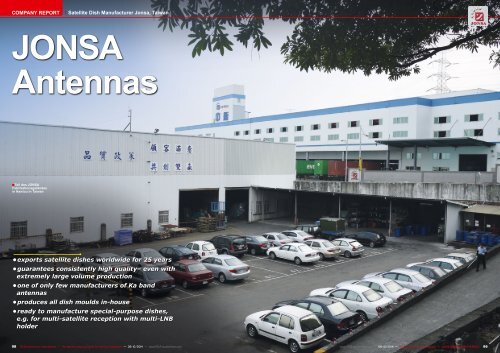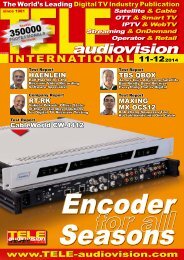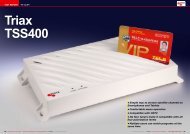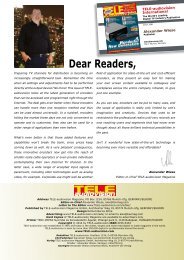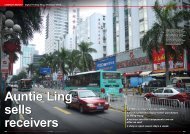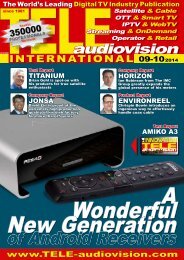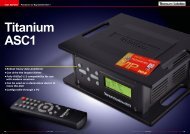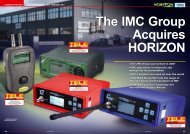JONSA Antennas
Create successful ePaper yourself
Turn your PDF publications into a flip-book with our unique Google optimized e-Paper software.
COMPANY REPORT<br />
Satellite Dish Manufacturer Jonsa, Taiwan<br />
<strong>JONSA</strong><br />
<strong>Antennas</strong><br />
■<br />
Teil des <strong>JONSA</strong><br />
Fabrikationsgeländes<br />
in Nantou in Taiwan<br />
• exports satellite dishes worldwide for 25 years<br />
• guarantees consistently high quality– even with<br />
extremely large volume production<br />
• one of only few manufacturers of Ka band<br />
antennas<br />
• produces all dish moulds in-house<br />
• ready to manufacture special-purpose dishes,<br />
e.g. for multi-satellite reception with multi-LNB<br />
holder<br />
98 TELE-audiovision International — The World‘s Leading Digital TV Industry Publication — 09-10/2014 — www.TELE-audiovision.com<br />
www.TELE-audiovision.com — 09-10/2014 — TELE-audiovision International — 全 球 发 行 量 最 大 的 数 字 电 视 杂 志 99
COMPANY REPORT<br />
Satellite Dish Manufacturer Jonsa, Taiwan<br />
ë<br />
Nantou,<br />
Taichung,<br />
Taiwan<br />
Major providers of pay TV via satellite<br />
usually give their subscribers the<br />
necessary reception equipment free of<br />
charge, or – to put it in a more realistic<br />
way – the price is included in the<br />
monthly subscription fee. In most cases,<br />
those components are not manufactured<br />
by the content providers themselves,<br />
but rather are sourced from<br />
third-party manufacturers which act as<br />
OEMs or ODMs.<br />
If you’re in the OEM business and are<br />
looking for a steady flow of orders and<br />
revenue from content providers, one<br />
of the key requirements is consistently<br />
high quality. <strong>JONSA</strong> is an excellent example<br />
for that. The Taiwanese company<br />
was founded in 1988 and has been<br />
producing satellite antennas for leading<br />
satellite pay TV providers around the<br />
world. What made <strong>JONSA</strong> such a major<br />
player? There is only one way to find<br />
out and so we embarked on a journey<br />
to Nantou in Taiwan. Nantou is a rather<br />
small town close to Taichung in western<br />
Taiwan, yet it is here that <strong>JONSA</strong><br />
has set up its administrative offices and<br />
huge production halls.<br />
The business was founded by David<br />
Lin in 1988 and up to this very day he<br />
is owner and chairman of <strong>JONSA</strong>. Originally,<br />
<strong>JONSA</strong> was in the business of<br />
erecting large halls or – more precisely<br />
– of producing metal walls for setting<br />
up halls. So come to think of it, it was a<br />
pretty small step from straight walls to<br />
parabolic shaped antennas.<br />
The first model introduced by <strong>JONSA</strong><br />
was a 120cm dish which at the time<br />
was lathed from a single sheet of metal.<br />
Initially, production volumes were tiny:<br />
“<strong>JONSA</strong>’s monthly output was roughly<br />
■<br />
David Lin is<br />
founder, owner<br />
and chairman of<br />
<strong>JONSA</strong>.<br />
■<br />
Main entrance<br />
to <strong>JONSA</strong>.<br />
Quality antennas<br />
for the world’s<br />
largest content<br />
providers<br />
100 TELE-audiovision International — The World‘s Leading Digital TV Industry Publication — 09-10/2014 — www.TELE-audiovision.com<br />
www.TELE-audiovision.com — 09-10/2014 — TELE-audiovision International — 全 球 发 行 量 最 大 的 数 字 电 视 杂 志 101
■<br />
Visitors are welcomed to<br />
the <strong>JONSA</strong> headquarters.<br />
ten antennas,” Mr. Anthony fondly remembers<br />
the company’s pioneering<br />
days. He is the person in charge of the<br />
company’s sales team and responsible<br />
for communication with key account<br />
customers. While the first <strong>JONSA</strong> dishes<br />
were made for C band reception, export<br />
of Ku band antennas also began<br />
as early as 1989. “Our first export year<br />
saw shipment of approximately 24,000<br />
antennas,” Mr. Anthony recalls with<br />
pride.<br />
These days, however, <strong>JONSA</strong> plays<br />
in an entirely different league: “We<br />
produce about 15 million dishes per<br />
year.” Which satellite bands are covered<br />
today? “80% of our output are<br />
Ku band antennas, 10% are designed<br />
for C band reception, 5% for the S and<br />
L bands and another 5% take care of<br />
the Ka band.” This latter segment is on<br />
an enormous upswing, however, since<br />
<strong>JONSA</strong> is one of only a select few manufacturers<br />
worldwide capable of manufacturing<br />
antennas for this rather tricky<br />
frequency band. And if you’re in such a<br />
position of strength the prospects for<br />
an additional increase in Ka band sales<br />
are looking excellent.<br />
Most of <strong>JONSA</strong>’s satellite antennas<br />
are purchased by large pay TV providers<br />
or – in the case of Ka band dishes –<br />
providers of Internet via satellite. Since<br />
this is currently only offered in North<br />
America and Europe on a larger scale,<br />
those companies are rare and far in between.<br />
So chances are the Ka band antennas<br />
they use are manufactured by<br />
<strong>JONSA</strong>. “We have concluded non-disclosure<br />
agreements with all providers,<br />
so we’re not in a position to give you<br />
their names,” Mr. Anthony explains the<br />
high level of confidentiality maintained<br />
by <strong>JONSA</strong>.<br />
<strong>JONSA</strong> has a markedly global strategy,<br />
and the numbers Mr. Anthony provides<br />
lend impressive proof to that approach:<br />
“70% of our production output<br />
is shipped to the Americas, with North<br />
America the final destination for half of<br />
those antennas, and Central and South<br />
America for the other half. 10% go the<br />
Middle East and 5% reach Europe.” We<br />
notice that Africa is not on that list at<br />
all. True, but it is a market for which<br />
<strong>JONSA</strong> envisages enormous potential<br />
for development and expansion, which<br />
is in the process of being launched.<br />
“Our local agent does excellent fieldwork,<br />
particular in sub-Saharan Africa,<br />
which we have earmarked for strong<br />
business growth.” The South American<br />
market is also set to embark on continuous<br />
expansion, not least due to the<br />
Olympic Games in Brazil that will take<br />
place in 2016. “Demand for Ka band<br />
antennas also experiences promising<br />
growth,” Mr. Anthony reveals, “and between<br />
2006 and 2013 we have shipped<br />
a total of six million Ka band dishes<br />
with 66cm and 75cm to North America<br />
alone.”<br />
Those figures are truly impressive,<br />
and they also hint at the fact that JON-<br />
SA’s Nantou production premises are<br />
not able to handle all that demand on<br />
their own. “Here in Nantou we focus<br />
on Ka band and Ku band antennas. We<br />
set up an additional production facility<br />
in the Chinese city of Nanjing as far<br />
back as 1993, where we manufacture<br />
all panel antennas and C band dishes.”<br />
As a matter of fact, the Chinese<br />
workforce already outnumbers that in<br />
Taiwan. “500 staff work for <strong>JONSA</strong> in<br />
China, while the corresponding number<br />
in Taiwan stands at 400.” At the Nantou<br />
headquarters of <strong>JONSA</strong> there is also<br />
the administrative building for some<br />
35 employees, the sales and marketing<br />
team with 17 members of staff and –<br />
first and foremost – the R&D department<br />
with a workforce of 25.<br />
“When it comes to antenna production,<br />
we never stop improving. What’s<br />
more, the demands placed on manufacturers<br />
are always rising as well. The<br />
Ka band, in particular, requires a great<br />
deal of attention to detail and excellent<br />
precision all through the production<br />
chain,” Mr. Anthony explains and adds:<br />
“While the accuracy tolerance in Ku<br />
102 TELE-audiovision International — The World‘s Leading Digital TV Industry Publication — 09-10/2014 — www.TELE-audiovision.com
and antenna production may exceed<br />
0.5 mm RMS (root main square), for Ka<br />
band dishes it must be lower than 0.25<br />
mm.” This is also one of the reasons<br />
why <strong>JONSA</strong> has set up a top-notch quality<br />
lab for continuously evaluating – and<br />
ultimately improving – the quality of its<br />
satellite antennas.<br />
“This is our secret of success, and<br />
there are some pay TV providers which<br />
have been cooperating with us for the<br />
last 20 years. This can only work if<br />
the quality is right, if it is permanently<br />
checked and if our customers can rely<br />
on consistently high production and<br />
product quality.”<br />
■<br />
Inside the <strong>JONSA</strong> showroom,<br />
where some of the antenna<br />
models of the <strong>JONSA</strong> range are<br />
presented.<br />
104 TELE-audiovision International — The World‘s Leading Digital TV Industry Publication — 09-10/2014 — www.TELE-audiovision.com<br />
www.TELE-audiovision.com — 09-10/2014 — TELE-audiovision International — 全 球 发 行 量 最 大 的 数 字 电 视 杂 志 105
1. Moulds are required for pressing individual<br />
satellite antennas. This machine cuts a new<br />
mould for a 150cm satellite dish according to a<br />
pay TV customer’s bespoke specifications.<br />
2. The finished moulds undergo post-treatment<br />
here and are then inserted into the press tools.<br />
3. The company’s warehouse hosts a large<br />
variety of moulds for different sizes and types of<br />
antennas.<br />
4. Small 60cm antennas are pressed here.<br />
<strong>JONSA</strong> operates a total of 11 large presses at<br />
its main location in Taiwan, and another 13 at its<br />
Chinese productions facilities.<br />
3<br />
1<br />
4<br />
2<br />
106 TELE-audiovision International — The World‘s Leading Digital TV Industry Publication — 09-10/2014 — www.TELE-audiovision.com
5<br />
7 8<br />
5. This is how antennas are pressed: The roll on<br />
the left consists of endless sheet metal, with a new<br />
roll of 0.8mm sheet metal weighing 2,200kg. The<br />
metal is fed from the roll to the large press fully<br />
automatically. Next, antennas are put into shape<br />
from that sheet metal with a pressing force of up<br />
to 600 tonnes. Large presses like this one have an<br />
hourly output of up to 500 antennas with a diameter<br />
of 60cm.<br />
6. View of one of the production floors where<br />
mounting components for satellite antennas are<br />
manufactured.<br />
7. View of the production floor with large presses,<br />
which make antennas out of pre-cut metal. These<br />
presses are perfectly suited for the production of<br />
smaller antennas, such as the 45cm variant.<br />
8. Feedarm holder production: Pre-cut tubes are<br />
ready for assembly.<br />
6<br />
108 TELE-audiovision International — The World‘s Leading Digital TV Industry Publication — 09-10/2014 — www.TELE-audiovision.com<br />
www.TELE-audiovision.com — 09-10/2014 — TELE-audiovision International — 全 球 发 行 量 最 大 的 数 字 电 视 杂 志 109
9<br />
11<br />
10<br />
12<br />
9. The tubes need to be<br />
placed into the feeding<br />
section of the machine.<br />
10. The machine then grabs<br />
one tube after the other and<br />
bends it according to predefined<br />
specifications.<br />
11. The holders leave the<br />
bending machine.<br />
12. The mounting holes are<br />
then punched out manually.<br />
13. Complete mounting<br />
systems are punched at this<br />
production line.<br />
13<br />
110 TELE-audiovision International — The World‘s Leading Digital TV Industry Publication — 09-10/2014 — www.TELE-audiovision.com
14. It would take one hour to travel one entire journey from beginning to end on this<br />
400m endless conveyor belt. It goes without saying that <strong>JONSA</strong> only uses non-toxic<br />
and RoHS-certified paints.<br />
15. All finished satellite antennas and mounting components are spray-painted with<br />
weather-proof paint at this huge spray-painting facility. <strong>JONSA</strong> runs four of those<br />
painting facilities where 22,000 individual pieces are painted in a two-shift operation.<br />
16. Clad in an overpressure suit a <strong>JONSA</strong> member of staff refills one of the paint<br />
chambers.<br />
17. Random sampling takes place at the end of the conveyor belt to make sure enough<br />
paint is applied to antennas and components.<br />
18. All finished components for a satellite antenna complete with all mounting<br />
components are packaged here and made ready for despatch to customers – in the<br />
case of <strong>JONSA</strong> these consist of large pay TV providers and major national distributors.<br />
14<br />
15 16 17 18<br />
112 TELE-audiovision International — The World‘s Leading Digital TV Industry Publication — 09-10/2014 — www.TELE-audiovision.com<br />
www.TELE-audiovision.com — 09-10/2014 — TELE-audiovision International — 全 球 发 行 量 最 大 的 数 字 电 视 杂 志 113
19<br />
20<br />
25<br />
28<br />
21<br />
Quality Assurance at <strong>JONSA</strong><br />
19. Mechanical components such as pole holders and feedarm holders<br />
must be attached to the antenna in a way that guarantees similar<br />
durability to that of the dish itself. A saltwater test lab is used to<br />
evaluate the quality of the components (screws, nuts, clamps, etc.)<br />
by spraying them with saltwater for 100 hours. This corresponds to<br />
roughly 5 to 7 years of actual outdoor use.<br />
20. Individual antennas are taken from the production chain on a<br />
regular basis and checked with a precision laser to make sure their<br />
form and shape is up to specifications. These spot checks are carried<br />
out automatically. The only thing a <strong>JONSA</strong> employee has to do is put<br />
the antenna in place and initiate the checking process.<br />
21. A laser scan with manual operation is available to check larger<br />
antennas as well.<br />
23<br />
22. Specimens of all accessory components like clamps and<br />
pole holders are stored here. Components from the actual<br />
production chain are checked for accuracy against these<br />
specimens on a regular basis.<br />
23. The result of an optical 3D check. The calculated<br />
measurement results are compared with the corresponding<br />
value of the production plan to determine the manufacturing<br />
tolerance.<br />
24. An optical 3D device is used to determine the accuracy<br />
of components such as clamps and pole holders.<br />
25. The quality assurance library hosts all sample plans for<br />
production.<br />
26. An electron microscope is used to have an in-depth look<br />
at the surface of an antenna component.<br />
27. The surface of components is checked with this x-ray<br />
device.<br />
28. How do components made of plastic (such as LNB<br />
holders) react to continuous exposure to sunlight? This<br />
UV test unit gives the answer. Components – or parts<br />
thereof – are mounted on slots and exposed to UV radiation.<br />
Exposure over 1000 hours is equivalent to a real-world<br />
exposure of one year. <strong>JONSA</strong> tests its components for a<br />
service life of eight years.<br />
29. Stretching and punching: The robustness and<br />
sturdiness of antennas can be tried and tested with this<br />
machine. It stretches and punches components and at the<br />
same time measures how much the tested material gives<br />
way under pressure.<br />
22<br />
29<br />
24<br />
26<br />
27<br />
114 TELE-audiovision International — The World‘s Leading Digital TV Industry Publication — 09-10/2014 — www.TELE-audiovision.com<br />
www.TELE-audiovision.com — 09-10/2014 — TELE-audiovision International — 全 球 发 行 量 最 大 的 数 字 电 视 杂 志 115
30<br />
33<br />
32<br />
30. Carl Chen is the head of Supply Chain<br />
Management. His position is paramount<br />
for guaranteeing a flawless production<br />
process and maintaining consistently<br />
high quality.<br />
31. Stanley Chiang is production<br />
manager at <strong>JONSA</strong> and has the entire<br />
production operations under his control.<br />
32. Jimmy works as product manager and<br />
is responsible for product development.<br />
33. There’s no shortage of technical<br />
challenges at <strong>JONSA</strong>. At the moment<br />
all eyes are on the Ka band with<br />
its extremely detailed and precise<br />
requirements. Rick Tseng is the manager<br />
in charge of the R&D team. Here he is<br />
seen in the test lab, looking at a Ka band<br />
feed made by <strong>JONSA</strong>.<br />
34. 17 members of staff in the Sales Team<br />
act as interface between <strong>JONSA</strong> and its<br />
customers. Among them are Paula Chen<br />
(left), who is in charge of marketing, and<br />
Conny Chen (right), head of Sales.<br />
31<br />
34<br />
116 TELE-audiovision International — The World‘s Leading Digital TV Industry Publication — 09-10/2014 — www.TELE-audiovision.com<br />
www.TELE-audiovision.com — 09-10/2014 — TELE-audiovision International — 全 球 发 行 量 最 大 的 数 字 电 视 杂 志 117


